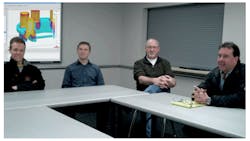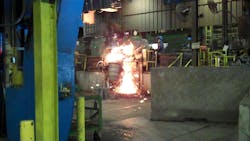Dotson Iron Castings Verifies its Simulation Investment
Dotson Iron Castings in Mankato, MN, is an iron foundry that melts and pours over 100 tons/day of ductile iron castings, using 20X24 horizontal, high-pressure, green sand molding machines. Its products include over 3,000 different castings for more than 300 customers producing medical and recreational equipment and machines for transportation, agriculture, and construction. The raw casting weights range from 2 to 50 lb., and typical production quantities range from 25pieces to several thousand.
Dotson is proud of its engineering capabilities, and aims to provide customers a higher total value with castings designed and produced in a highly automated, quick response foundry and machining operation.
Operating as a foundry for more than 130 years, and Dotson credits its success to satisfying customer needs by managing, and exceeding, their expectations. The goal is to providecustomers with quality products in a fast, flexible, cost-effective manner. One of Dotson’s “best practices” is to include its employees in all major decisions that will impact individuals’ jobs as well as thewhole foundry.
Dotson’s “$10,000 Project” program involves a decision-making process prior to any purchase of $10,000 or more is done, a detailed process involving the employees who will be most affected by the purchase of the product or equipment being considered.
Any product or project that costs over $10,000 must have a cross-functional group examine all viable options. Members of the group choose what they consider the best product or equipment to help them accomplish their goals. Then, they visit locations, make comparisons and do cost justifications. With the information they have gathered, they make multiple presentations to the group explaining the “what” and the “why” of the product, equipment or service they are considering.
Dotson Iron Castings owner Denny Dotson and president and CEO Jean Bye wanted to expand their capabilities in terms of serving customers with solidification solutions, MAGMASOFT, provided by MAGMAFoundry Technologies was one of the many software packages they considered.
“We certainly are a foundry that differentiates ourselves on our engineering services and to do that you must have the right tools,” Jean Bye explained. “We researched and explored our options for a few years before making the decision to purchase simulation software for the foundry,” Denny Dotson added.
The $10,000 Project
The $10,000 Project is a lengthy process with the participants sometimes making three or four presentations to support their argument. It took a long time to decide on the simulation software that supported Dotson Iron best, due to the need to conduct numerous comparisons. When comparing the benefits of all the products being considered, “… it came down to weighing out the factors and deciding which ones would have the greatest impact on the overall foundry operation,” according to Bye.
When the $10,000 Project is complete and a decision has been made, nobody can say they weren’t onboard. “They might not have gotten their way,” Bye noted,“but they certainly understand all the reasons that the decision was made, because it was well thought out by the entire group.”
Dotson Iron saw that adopting simulation software would be more than just an engineering tool; rather, it represented a smart business tool specificallydesigned to improve yield, as well as to impact sales positively. There was a lot to consider in the justification process beyond the product’s capabilities. Ease and speed of use, accuracy of results, presentation of those results, reputation of the provider’s company, customer care, quick response time from company representatives when there was a question or assistance was needed, as well as which company Dotson Iron felt was more technologically advanced with new innovations.
In addition, a significant benefit Dotson saw with simulationwas the ability to identify jobs that would require some type of stress relief before actually making the tool or gating system. “It’s much more difficult to go back to the customer after the fact and tell them this is your cost, than it is before you cut the tool. There are always options before anything is created,” engineering process manager Jim Headington pointed out
“Moving from opinion or educated guess to a factual report supporting changes has made it quicker and easier to communicate the need for making changes with our customers,” added Jay Zins, control manager at Dotson Iron Castings.
Simulation's impact
When discussing the impact simulating the process has on time to first quality part, Headington explained, “Time isn’t always the most important issue at hand. Cost and the integrity of the tool by the time you’re done with it are the real keys. When you find yourself adding material to a production tool, it’s never a good thing. Once you scab on that material, no matter how you put it on, you’ve really jeopardized the integrity of the tool. This is all now done virtually, instead of through trial and error.”
On one recent casting project, Dotson ran approximately 30 virtual iterations on a particular part. Not only did having the ability to simulate the entire molding process save a significant amount of time, being able to run a large number of iterations also helped them be sure that the quality of the part was not compromised. “Once in a while, on projects like this, we do 30 simulated iterations, simply because we now can,” Josh Jaycox, quality assurance engineer added.
While all new jobs at Dotson Iron are run through MAGMASOFT, retro jobs, especially the high yield jobs, are simulated now, too.
A significant part of the justification process was improving yield. When considering yield improvements, Dotson recognized that the improvement in the first year will normally be significant, as they hadn’t run simulation before; whereas, moving forward, improving yield would be less significant, as all new jobs are now run through the simulation and, as a result, are more efficient from the very beginning.
“Running the software on a casting also will help us see that it may be possible to make a risersmaller, this will help in de-gating and reduce grinding time.” Jaycox said.
Sales and marketing manager Matt Schindle added, “The benefit to the customer is that they know we are not going to build a tool, we are not going to spend a dollar of their money, until we have done the solidification on it. It gives us more credibility and it gives the customer reassurance.”
“It’s almost like having a third party in the room giving our observations credibility,” Bye emphasized.
Seeing the importance of being sure their foundry and their engineers have the tools to be the best they can be, Dotson found that adding MAGMASOFT was a natural step. When considering the in-depth justification process and the criteria involved in bringing a new product or tool into the foundry, they learned their decision regarding process simulationto be a great benefit to the company overall. Dotson realized customers now expect and rely on the fact that their parts are run through this virtual process with the end result being the highest quality castings possible.
Choosing MAGMASOFT, Dotson believed all their performance and value criteria were met — and in many cases, exceeded. MAGMA’s reputation in the global foundry market and its customer care program, as well as the benefits of their training programs and user meetings, give Dotson Iron Castings confidence in its partnership with MAGMA.
See the companion piece to this article, "Tell Us More."
About the Author
Robert Brooks
Content Director
Robert Brooks has been a business-to-business reporter, writer, editor, and columnist for more than 20 years, specializing in the primary metal and basic manufacturing industries. His work has covered a wide range of topics, including process technology, resource development, material selection, product design, workforce development, and industrial market strategies, among others.

